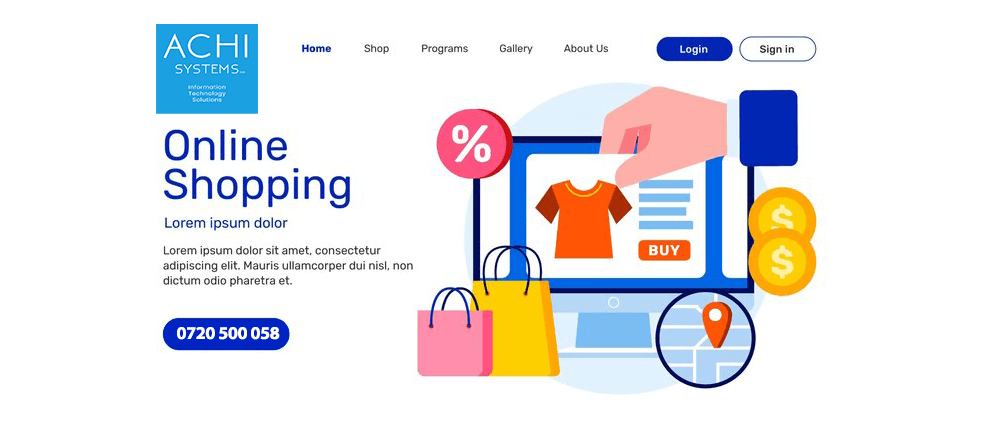A well-designed e-commerce website is crucial for businesses aiming to succeed in the competitive online marketplace. It acts as a virtual storefront, influencing how customers perceive the brand and whether they make a purchase. For an e-commerce site to stand out and effectively drive sales, it must combine functionality, aesthetics, and user-centric design. Here are the essential features of a well-designed e-commerce website:
1. User-Friendly Navigation
Why It Matters
Clear and intuitive navigation ensures that visitors can find what they are looking for quickly and easily. A website with well-organized menus, categories, and search options minimizes frustration and improves user experience.
Key Elements
- Search Bar: A prominent and fast search bar with auto-suggestions.
- Categorization: Logical grouping of products into categories and subcategories.
- Breadcrumbs: A trail that helps users track their navigation path.
2. Responsive Design
Why It Matters
A responsive design adapts seamlessly to devices of different screen sizes, ensuring a smooth browsing experience for users on desktops, tablets, and smartphones.
Key Elements
- Mobile Optimization: The site should be fully functional and visually appealing on mobile devices.
- Fast Loading Times: Optimized images and coding for quick load speeds.
3. High-Quality Visuals
Why It Matters
Images and videos greatly influence purchasing decisions by providing customers with a clear view of the product.
Key Elements
- Professional Photography: Clear, high-resolution images of products from multiple angles.
- Product Videos: Videos demonstrating the product in use.
- Zoom Feature: Allows customers to examine product details closely.
4. Secure Payment Gateway
Why It Matters
Security is a top priority for customers when entering personal and financial information.
Key Elements
- SSL Certification: Encrypts data to protect customer information.
- Multiple Payment Options: Include credit cards, mobile payments, and digital wallets like PayPal.
- Secure Checkout Process: Minimized steps with clear indicators of security.
5. Easy Checkout Process
Why It Matters
A streamlined checkout process reduces cart abandonment rates and improves conversion.
Key Elements
- Guest Checkout Option: Allows customers to purchase without creating an account.
- Progress Indicators: Show checkout steps to keep users informed.
- Auto-Fill Fields: Save time by auto-completing forms.
6. Detailed Product Descriptions
Why It Matters
Comprehensive product descriptions help customers make informed purchasing decisions.
Key Elements
- Key Features: Highlight specifications, materials, and sizes.
- Usage Instructions: Provide guidance on how to use the product.
- Customer Reviews: Real feedback from previous buyers.
7. Personalization
Why It Matters
Personalization enhances user experience and boosts customer satisfaction.
Key Elements
- Product Recommendations: Suggest related or popular items based on browsing history.
- Customizable Filters: Allow users to sort products by price, size, color, or ratings.
- Wishlist Feature: Enables users to save items for later.
8. Strong Call-to-Actions (CTAs)
Why It Matters
Clear and compelling CTAs guide users toward completing desired actions, such as making a purchase.
Key Elements
- Visible Buttons: CTAs like “Buy Now” or “Add to Cart” should stand out.
- Urgency Messaging: Phrases like “Limited Stock” or “Sale Ending Soon” encourage quick decisions.
9. Robust Customer Support
Why It Matters
Accessible support builds trust and improves customer satisfaction.
Key Elements
- Live Chat: Instant assistance for queries.
- FAQs Section: Answers to common customer questions.
- Contact Information: Display phone numbers, email addresses, and response times.
10. Comprehensive Analytics
Why It Matters
Analytics tools help businesses monitor performance, understand customer behavior, and optimize their site.
Key Elements
- Sales Tracking: Monitor revenue and product performance.
- Visitor Insights: Understand how users interact with the website.
- A/B Testing: Test different layouts or features to improve usability.
11. Trust Indicators
Why It Matters
Trust indicators reassure customers about the credibility of the website.
Key Elements
- Customer Testimonials: Display positive reviews and ratings.
- Trust Badges: Show certifications, such as secure payment logos.
- Return Policies: Clearly state refund and exchange terms.
12. Social Media Integration
Why It Matters
Integrating social media encourages engagement and builds a stronger online presence.
Key Elements
- Share Buttons: Allow users to share products on platforms like Facebook, Instagram, or Twitter.
- Social Proof: Display user-generated content from social media.
13. Search Engine Optimization (SEO)
Why It Matters
SEO ensures that the website ranks well on search engines, driving more organic traffic.
Key Elements
- Keyword Optimization: Use relevant keywords in product titles, descriptions, and meta tags.
- Fast Loading Speed: Improves search engine rankings.
- Mobile-Friendliness: Optimized for mobile search.
14. Regular Updates and Maintenance
Why It Matters
Frequent updates ensure that the website remains secure, functional, and relevant.
Key Elements
- Bug Fixes: Address technical issues promptly.
- Content Updates: Refresh product listings and promotions.
- Security Patches: Regular updates to prevent breaches.
A well-designed e-commerce website is not just about aesthetics but also functionality and user experience. By incorporating these features, businesses can attract and retain customers, drive sales, and establish a strong online presence. Whether you’re starting an online store or revamping an existing one, these elements are essential for success
